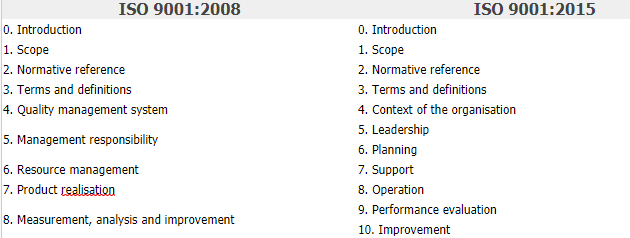After three months of hard work, Lok Mei upgraded the ISO 9001 management system from the 2008 version to 2015. ISO 9001 is a standard of good professional level. This system is a tool that Lok Mei can determine how to meet the requirements of customers and other relevant parties involved in other activities.
You can contact us to get the latest ISO certificate copy.
The following is the change of our Lok Mei ISO quality management system
ISO 9001: 2015 has ten clauses instead of eight. The following table shows the relationship between the provisions of ISO 9001: 2008 and the new version of ISO 9001: 2015.

The first three clauses in ISO 9001: 2015 are roughly the same as the first three clauses in ISO 9001: 2008, but starting from the fourth clause, there is a big difference between ISO 9001: 2008 and ISO 9001: 2015. The last seven clauses are now arranged according to the PDCA cycle (plan, do, check, act). The figure below shows this.
SO 9001: 2015 pays more attention to input and output
In ISO 9001: 2015, more emphasis is placed on the input and output of the measurement and appropriate evaluation process. According to ISO 9001: 2015, you must closely monitor which items, information and specifications are involved in the production process. You must also clearly check whether good articles are out of the production process.
The core of ISO 9001: 2015: Thinking based on risk
Risk-based thinking has a very important position in ISO 9001: 2015. Now Lemei is also using risk analysis for the organization in order to decide for management what challenges are seen in business process management.
Increasing risk thinking has doubled the "preventive measures" of ISO 9001: 2008. These precautions no longer appear in ISO 9001: 2015.
The importance of organizational background in ISO 9001: 2015
ISO 9001: 2015 requires organizations to build a quality management system from a specific activity environment from now on. This means that as an organization, Lemei must take into account the needs and expectations of relevant parties, and evaluate and deal with internal and external strategic issues. You must show that as an organization, Lemei management and its employees need to understand and respond to the expectations of all parties involved.
ISO 9001: 2015 and participation of interest groups
In ISO 9001: 2008, the customer is usually regarded as the only interested party. This concept was expanded in ISO 9001: 2015. Suppliers, personnel, shareholders, legislative bodies, society, internal customers, etc. are listed as relevant parties in addition to customers.
As an organization, LeMee must understand the importance of these interested parties (changes) requirements and standards and consider them as considerations for products and services.
However, this has always been part of another form of standard. Therefore, Lemei is expected to have to implement major changes in this regard. In any case, we cannot manufacture or deliver high-quality products without understanding the requirements and expectations of customers and related parties. This is the foundation of the quality management system.
ISO 9001: 2015 leadership and commitment
ISO 9001: 2015 also pays more attention to leadership and management commitment. Senior management and business leaders need more participation to control the quality management system.
In this way, ISO 9001: 2015 aims to encourage integration and coordination with business processes and business strategies. Senior management must now take more responsibility for the effectiveness of the quality management system.
Since ISO 9001: 2015 pays more attention to risk management, stakeholders and the organizational environment, the quality management system is more in line with the needs of senior management.
The quality management system is now more than ever a means of achieving strategic success by meeting the needs of relevant parties and managing opportunities and threats.
The “management representative” of ISO 9001: 2008 is a member of the management committee and is responsible for guiding the correct route of the quality management system. ISO 9001: 2015 never mentions this aspect again. The idea behind the change is that quality is a problem for everyone and every level of the organization.
Different terms in ISO 9001: 2008 and ISO 9001: 2015
The following table is a brief summary of the important changes in terms compared to ISO 9001: 2008.



